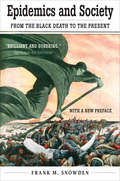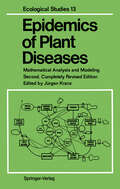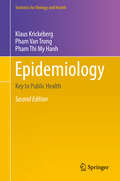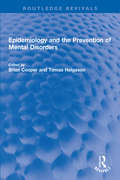- Table View
- List View
Epidemics and Society: From the Black Death to the Present (The Open Yale Courses Series)
by Frank M. SnowdenA wide-ranging study that illuminates the connection between epidemic diseases and societal change, from the Black Death to Ebola This sweeping exploration of the impact of epidemic diseases looks at how mass infectious outbreaks have shaped society, from the Black Death to today. In a clear and accessible style, Frank M. Snowden reveals the ways that diseases have not only influenced medical science and public health, but also transformed the arts, religion, intellectual history, and warfare. A multidisciplinary and comparative investigation of the medical and social history of the major epidemics, this volume touches on themes such as the evolution of medical therapy, plague literature, poverty, the environment, and mass hysteria. In addition to providing historical perspective on diseases such as smallpox, cholera, and tuberculosis, Snowden examines the fallout from recent epidemics such as HIV/AIDS, SARS, and Ebola and the question of the world’s preparedness for the next generation of diseases.
Epidemics of Plant Diseases: Mathematical Analysis and Modeling (Ecological Studies #13)
by Jürgen KranzIn this volume experts present the latest status of mathematical and statistical methods in use for the analysis and modeling of plant disease epidemics. Topics treated are - methods in multivariate analyses, ordination and classification, - modeling of temporal and spatial aspects of air- and soilborne diseases, - methods to analyse and describe competition among subpopulations, e.g. pathogen races and - their interaction with resistance genes of host plants - assemblage and use of models - mathematical simulation of epidemics. New chapters on the modeling of the spreading of diseases in air and in soil are included in this second edition.
Epidemien und Pandemien in historischer Perspektive: Epidemics and Pandemics in Historical Perspective (Edition Centaurus – Neuere Medizin- und Wissenschaftsgeschichte)
Im Zentrum dieses Sammelbandes stehen neue Forschungsergebnisse interdisziplinärer Autorinnen und Autoren aus sieben Ländern zum Thema Seuchen. Seuchen verbreiten zunächst Unsicherheiten, so dass historische Beispiele und Denkweisen herangezogen werden, um Gefahren zu erkennen und Gegenmaßnahmen zu treffen. Solche Traditionen lassen sich über Jahrhunderte zurück verfolgen. So werden in diesem Band die Rekonstruktion von Fakten in Zeit und Raum (global vs. local) sowie die Einflüsse auf das Kulturleben (cultural impact) und die der Wissenschaftsgeschichte (Science studies) analysiert. Einführend und abschließend werden Forschungsstand und -perspektiven zur Sozialgeschichte der Medizin diskutiert.
Epidemiological and Molecular Aspects on Cholera (Infectious Disease)
by T. Ramamurthy and S.K. BhattacharyaThough cholera is an ancient disease, its perennial occurrence in several parts of the world has attracted many researches to find ways and means to combat the disease. The prevailing seventh pandemic cholera is dominating since 1961, but the dimension of the disease has taken several silhouettes, as the genetic structure and functions of the Vibrio cholerae has changed to a great extent. Several recent studies have shown that transformation of the pathogen at the molecular level has ameliorated several cholera outbreaks and epidemics of with successive new clones of V. cholerae. This comprehensive compilation, written by eminent international researchers reviews the epidemiology of cholera in Africa, Asia, Russia and Latin Americas. The other chapters contributed by acclaimed authors cover various aspects on evolution, polysaccaharide biosynthesis, SXT element, integrons, small molecule signalling systems, flagellar synthesis, filamentous phages, pathogenic role of proteases and hemolysin, and other putative virulence factors. In addition, ecology of V. cholerae and management of cholera were also discussed in detail. This book will be good source of information to all researchers with interests in infectious diseases, microbiology and molecular biology.
Epidemiological Practices in Research on Small Effects
by Hans Hoffmeister Moyses Szklo Michael ThammEpidemiology faces its limits: the search for subtle links between diet, lifestyle, or environmental factors and disease is an unending source of fear - but often yields little certainty. Studies on weak associations - or small effects - often produce contradictory results which confuse the public. In this book, numerous contributions and illustrated examples show the effects of this problem, and sets out how future research should be approached in order to minimize the problems, thus producing clear results of significance.
Epidemiological Research: Terms and Concepts
by O. S. MiettinenThe book is organized so as to address in separate sections first the preparatory topics of medicine (clinical and epidemiological), science in general, and statistics (mathematical); then topics of epidemiological research proper; and, finally, topics of ‘meta-epidemiological’ clinical research. In those two main sections, a further grouping is based on the distraction between objects and methods of study. In this framework, the particular topics are addressed both descriptively and quasi-prescriptively, commonly with a number of explicatory annotations.This book is intended to serve as a handbook for whomever is, in whatever way, concerned with epidemiological or ‘meta-epidemiological’ clinical research. But besides this, it is also intended to serve as a textbook for students in introductory courses on ‘epidemiological’ research – to which end there is a suggested hierarchy of the concepts that might reasonably be covered.
Epidemiologische Methoden
by Lothar Kreienbrock Iris Pigeot Wolfgang AhrensZiel dieses Buches ist es, die für epidemiologische Studien notwendigen methodischen Kenntnisse zu vermitteln. Dazu werden die Konzepte der Konstruktion und Gewinnung epidemiologischer Maßzahlen, die wichtigsten Erhebungsmethoden, die Bewertung und Korrektur von Fehlerquellen sowie die grundlegenden Auswertungsmethoden beschrieben. Die statistischen Methoden werden in einem eigenen Anhang beschrieben. In der 5. Auflage wurden das Autorenteam erweitert und der Text umfangreichen Erweiterungen unterzogen. Enthalten sind eine Vielzahl von praktischen Beispielen.
Epidemiologische Untersuchung über die Häufigkeit der bakteriellen Niereninfektion in der Bevölkerung (Forschungsberichte des Landes Nordrhein-Westfalen #3007)
by Arno-Ekkehart LisonEpidemiology: Key to Prevention (Statistics for Biology and Health)
by Klaus Krickeberg Van Trong Pham Thi My PhamThis book is meant for adoption in first courses on epidemiology in Medical Schools and Faculties of Public Health in developing and transition countries and in workshops in these countries, taught for example by members of international organizations. It is also suitable for parallel or second reading within curricula in developed countries and for teaching epidemiology in a Master’s programme on “International Health”. The book will enable any lecturer to compose his or her introductory courses on epidemiology by selecting the material deemed appropriate. It will provide a solid foundation for more advanced teaching.The intended readership consists in the first place of general medical students; students following the programme “Preventive Physician” that runs parallel to general medical studies in some countries; students starting to specialize in Public Health; and lecturers in epidemiology. The book can also serve well as an introduction into epidemiology for anybody else interested in this field, for example staff of health institutions.Examples and practical work are taken from the present situation of health in Vietnam, which can easily be adapted to any other developing or transition country.
Epidemiology: Key to Public Health (Statistics for Biology and Health)
by Klaus Krickeberg Pham Van Trong Pham Thi My HanhThis unique textbook presents the field of modern epidemiology as a whole; it does not restrict itself to particular aspects. It stresses the fundamental ideas and their role in any situation of epidemiologic practice. Its structure is largely determined by didactic viewpoints.Epidemiology is the art of defining and investigating the influence of factors on the health of populations. Hence the book starts by sketching the role of epidemiology in public health. It then treats the epidemiology of many particular diseases; mathematical modelling of epidemics and immunity; health information systems; statistical methods and sample surveys; clinical epidemiology including clinical trials; nutritional, environmental, social, and genetic epidemiology; and the habitual tools of epidemiologic studies. The book also reexamines the basic difference between the epidemiology of infectious diseases and that of non-infectious ones.The organization of the topics by didactic aspects makes the book ideal for teaching. All examples and case studies are situated in a single country, namely Vietnam; this provides a particularly vivid picture of the role of epidemiology in shaping the health of a population. It can easily be adapted to other developing or transitioning countries.This volume is well suited for courses on epidemiology and public health at the upper undergraduate and graduate levels, while its specific examples make it appropriate for those who teach these fields in developing or emerging countries. New to this edition, in addition to minor revisions of almost all chapters:• Updated data about infectious and non-infectious diseases• An expanded discussion of genetic epidemiology• A new chapter, based on recent research of the authors, on how to build a coherent system of Public Health by using the insights provided by this volume.
Epidemiology and Biostatistics: An Introduction to Clinical Research
by Bryan KestenbaumThis is a concise introduction to epidemiology and biostatistics written specifically for medical students and first-time learners of clinical research methods. It presents the core concepts of epidemiology and of biostatistics and illustrates them with extensive examples from the clinical literature. It is the only book on the market written to speak directly to medical students and first-time biomedical researchers by using language and examples that are easy to understand. This newly updated second edition is extensively rewritten to provide the clearest explanations and examples. There is also a sister-text, a 150-problem workbook of practice problems that can be purchased alongside this textbook. The author continues to provide a text that is attractively fast-paced and concise for use in condensed courses, such as those taught in medical school. The book is an excellent review for the epidemiology section of the United States Medical Licensing Examination Part I which all medical students must take at the end of the second year.
Epidemiology and Biostatistics: Practice Problem Workbook
by Bryan KestenbaumThis workbook is designed to teach the major fundamental concepts in Epidemiology, Biostatistics, and clinical research design alongside the textbook "Epidemiology and Biostatistics, 2nd Edition". It is written in concise and organized fashion with many examples to illustrate the concepts deriving from a collection of written materials created to teach Epidemiology and Biostatistics to medical students. The major differences from related titles include a “story” based approach toward teaching the material, relative brevity while maintaining focus on key concepts, and taking the perspective of first-time learners (avoiding and/or clearly defining jargon, using clear common-sense language). It features a variety of questions: long, short, and multiple choice questions. The workbook is made to provide students with the tools necessary to form their own informed conclusions from the clinical research literature.
Epidemiology and Geography: Principles, Methods and Tools of Spatial Analysis
by Marc SourisLocalization is involved everywhere in epidemiology: health phenomena often involve spatial relationships among individuals and risk factors related to geography and environment. Therefore, the use of localization in the analysis and comprehension of health phenomena is essential. This book describes the objectives, principles, methods and tools of spatial analysis and geographic information systems applied to the field of health, and more specifically to the study of the spatial distribution of disease and health–environment relationships. It is a practical introduction to spatial and spatio-temporal analysis for epidemiology and health geography, and takes an educational approach illustrated with real-world examples.Epidemiology and Geography presents a complete and straightforward overview of the use of spatial analysis in epidemiology for students, public health professionals, epidemiologists, health geographers and specialists in health–environment studies.
Epidemiology and Geography: Principles, Methods and Tools of Spatial Analysis
by Marc SourisLocalization is involved everywhere in epidemiology: health phenomena often involve spatial relationships among individuals and risk factors related to geography and environment. Therefore, the use of localization in the analysis and comprehension of health phenomena is essential. This book describes the objectives, principles, methods and tools of spatial analysis and geographic information systems applied to the field of health, and more specifically to the study of the spatial distribution of disease and health–environment relationships. It is a practical introduction to spatial and spatio-temporal analysis for epidemiology and health geography, and takes an educational approach illustrated with real-world examples.Epidemiology and Geography presents a complete and straightforward overview of the use of spatial analysis in epidemiology for students, public health professionals, epidemiologists, health geographers and specialists in health–environment studies.
Epidemiology and Management of Root Diseases
by C. Lee Campbell D. Michael BensonRoot disease epidemics, because much of the activity takes place in soil and out of sight, pose special challenges to growers who seek to manage them and to scientists who study them. All relevant topics of root disease epidemics and their management are presented: The critical aspects of specific disease components including inoculum, host roots, mycorrhiza and the soil environment are explored. Challenges of disease assessment and the temporal and spatial aspects of epidemic development are considered, and approaches to root disease management including host resistance, chemical, biological and cultural management are discussed in detail. The book fulfills the needs of researchers, teachers, and practitioners of plant pathology.
Epidemiology and the Prevention of Mental Disorders (Routledge Revivals)
by Brian Cooper To 769 Mas HelgasonFirst published in 1989, Epidemiology and the Prevention of Mental Disorders examines the research undertaken into the methods for studying the occurrence of mental illness in populations during the twenty years prior to publication. The book explores the incidence and distribution of conditions such as schizophrenia, depression, alcoholism, addiction, and dementia across populations, and the risk factors with which they are associated. Taking a public health approach to the prevention of mental illness, the book reports on epidemiological research in psychiatry, emphasising its use in preventative terms, and making connections between its use in psychiatry and its use in other fields of medicine. It also comments on the development of psychiatric epidemiology as a public health discipline and draws attention to the implications of contemporary changes to biological and social environments on mental health. Epidemiology and the Prevention of Mental Disorders will appeal to those with an interest in the history of psychiatric epidemiology and mental health.
Epidemiology and the Prevention of Mental Disorders (Routledge Revivals)
by Brian Cooper To 769 Mas HelgasonFirst published in 1989, Epidemiology and the Prevention of Mental Disorders examines the research undertaken into the methods for studying the occurrence of mental illness in populations during the twenty years prior to publication. The book explores the incidence and distribution of conditions such as schizophrenia, depression, alcoholism, addiction, and dementia across populations, and the risk factors with which they are associated. Taking a public health approach to the prevention of mental illness, the book reports on epidemiological research in psychiatry, emphasising its use in preventative terms, and making connections between its use in psychiatry and its use in other fields of medicine. It also comments on the development of psychiatric epidemiology as a public health discipline and draws attention to the implications of contemporary changes to biological and social environments on mental health. Epidemiology and the Prevention of Mental Disorders will appeal to those with an interest in the history of psychiatric epidemiology and mental health.
Epidemiology of Brain and Spinal Tumors
by Jahangir Moini Nicholas Avgeropoulos Mohtashem SamsamEpidemiology of Brain and Spinal Tumors provides a single volume resource on imaging methods and neuroepidemiology of both brain and spinal tumors. The book covers a variety of imaging techniques, including computed tomography (CT), MRI, positron emission tomography (PET), and other laboratory tests used in diagnosis and treatment. Detailed epidemiology, various imaging methods, and clinical considerations of tumors of the CNS make this an ideal reference for users who will also find diverse information about structures and functions, cytology, epidemiology (including molecular epidemiology), diagnosis and treatment. This book is appropriate for neuroscience researchers, medical professionals and anyone interested in a complete guide to visualizing and understanding CNS tumors. - Provides the most up-to-date information surrounding the epidemiology, biology and imaging techniques for brain and spinal tumors, including CT, MRI, PET, and others - Includes full color figures, photos, tables, graphs and radioimaging - Contains information that will be valuable to anyone interested in the field of neurooncology and the treatment of patients with brain and spinal tumors - Serves as a source of background information for basic scientists and pharmaceutical researchers who have an interest in imaging and treatment
Epidemiology of Electromagnetic Fields
Appeals to a Wide AudienceFueled by more than 30 years of intensive research and debate on the impact of electromagnetic fields (EMF) on everyday life-starting with residential exposure to magnetic fields and the development of childhood cancer in the 70s and continuing with risk of exposure via wireless communications in present day-Epidemi
Epidemiology of Mycotoxin Producing Fungi: Under the aegis of COST Action 835 ‘Agriculturally Important Toxigenic Fungi 1998–2003’, EU project (QLK 1-CT-1998–01380)
by Xiangming Xu John A. Bailey B. Michael CookeUnder the aegis of COST Action 835 `Agriculturally Important Toxigenic Fungi 1998-2003', EU Project (QLK 1-CT-1998-01380)
The Epidemiology of Plant Diseases
by D. G. JonesMost branches of science have what might be termed a 'core area' which is both related to and helps to integrate peripheral topics to form the overall subject area. Without this central link, the subject is simply a collection of disparate, albeit gener ally related topics. What genetics is to plant breeding, epidemiology is to the subject of plant pathology and, no matter what individual topic is considered, it is always possible to recognize the interaction with and relationship to epidemiological factors. Broadly speaking, until the 1950s, plant pathology was considered as the applied side of mycology and, indeed, the British Society of Plant Pathology was spawned from its mentor, the British Mycological Society, with considerable help from The Association of Applied Biology. However, with the exploding world popu lation and the growing demand for food, plant pathologists became increasingly aware of the need for a more considered, measured, precise and even holistic approach to their subject and, particularly, to plant disease management. Looking back over 40 years of teaching and research in plant pathology, it was very clear that the 'core' of the subject was epidemiology and that this 'new' study was developing a very distinct identity which was rapidly being recognized in its own right. The 'shotgun' approach to plant disease 'control' was quickly perceived to be too inexact and almost every aspect of the subject was being reviewed, refined and advanced.
The Epidemiology of Plant Diseases
by D. Gareth Jones B. Michael Cooke Bernard KayePlant disease epidemiology is a dynamic science that forms an essential part of the study of plant pathology. This book brings together a team of 35 international experts. Each chapter deals with an essential component of the subject and allows the reader to fully understand how each exerts its influence on the progress of pathogen populations in plant populations over a defined time scale. This edition has new, revised and updated chapters.
Epidermal Cells: Methods and Protocols (Methods in Molecular Biology #1195)
by Kursad TurksenReflecting over three decades of advances, Epidermal Cells: Methods and Protocols, Third Edition underscores these advances in our understanding of epidermal biology with updated and entirely new protocols that compliment and extend the earlier edition. The inclusion of protocols useful for both in vitro and in vivo studies reflects many useful developments in the field. Written in the highly successful Methods in Molecular Biology series format, chapters include introductions to their respective topics, lists of the necessary materials and reagents, step-by-step, readily reproducible laboratory protocols and tips on troubleshooting and avoiding known pitfalls.Dependable and easy to follow, Epidermal Cells: Methods and Protocols, Third Edition serves researchers working to accelerate the work in this vital field of study.
Epidermal Cells: Methods and Protocols (Methods in Molecular Biology #289)
by Kursad TurksenA collection of cutting-edge methods to analyze and manipulate epidermal cellprecursors and mature epidermal cells. These protocols cover different methods and models for culturing epidermal cells, for enriching very early epidermal progenitors, and for studying epidermal cell commitment and differentiation both in vitro and in vivo. Topics of special interest include the derivation, characterization, and utility of epidermal stem cells, mature epidermal cells and their characterization, and applications in regenerative medicine. These readily reproducible techniques broaden our understanding of the biology of epidermal cells and of their utility in normal tissue homeostasis and regenerative medicine applications.
Epidermal Cells: Methods and Protocols (Methods in Molecular Biology #585)
by Kursad TurksenIn recent years, our ability to understand and manipulate epidermal cells has increased tremendously, opening significant new possibilities in both basic science research and in regenerative medicine, including would healing and transplantation. Epidermal Cells: Methods and Protocols, Second Edition expands upon the popular first edition by bringing together a panel of experienced basic and clinical researchers to describe in step-by-step detail the powerful methods they have developed and optimized to analyze and manipulate epidermal cell precursors and mature epidermal cells. These protocols cover different methods and models for culturing epidermal cells, for enriching very early epidermal progenitors, as well as for studying epidermal cell commitment and differentiation both in vitro and in vivo. Topics of special interest include the derivation, characterization, and utility of epidermal stem cells, mature epidermal cells and their characterization, and applications in regenerative medicine. The protocols follow the successful Methods in Molecular Biology™ series format, providing introductions to their respective topics, lists of the necessary materials and reagents, and notes on troubleshooting and avoiding known pitfalls. State-of-the-art and highly practical, Epidermal Cells: Methods and Protocols, Second Edition offers experienced and novice investigators alike an invaluable collection of readily reproducible techniques designed to broaden not only our understanding of the biology of epidermal cells, but also their utility in normal tissue homeostasis and regenerative medicine applications.






















